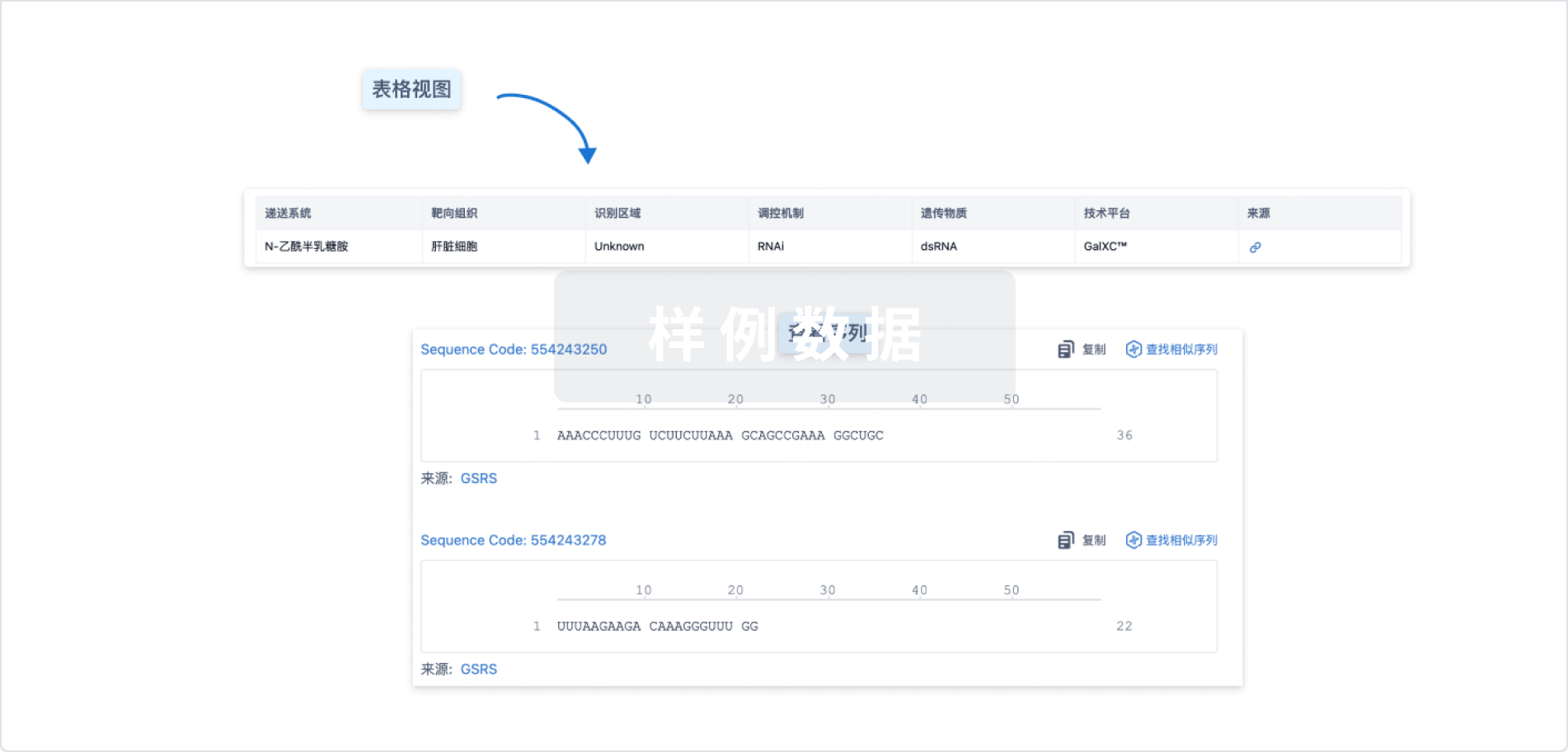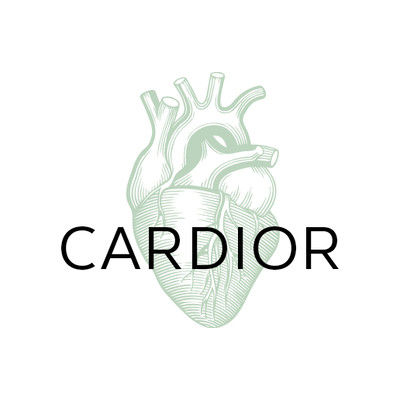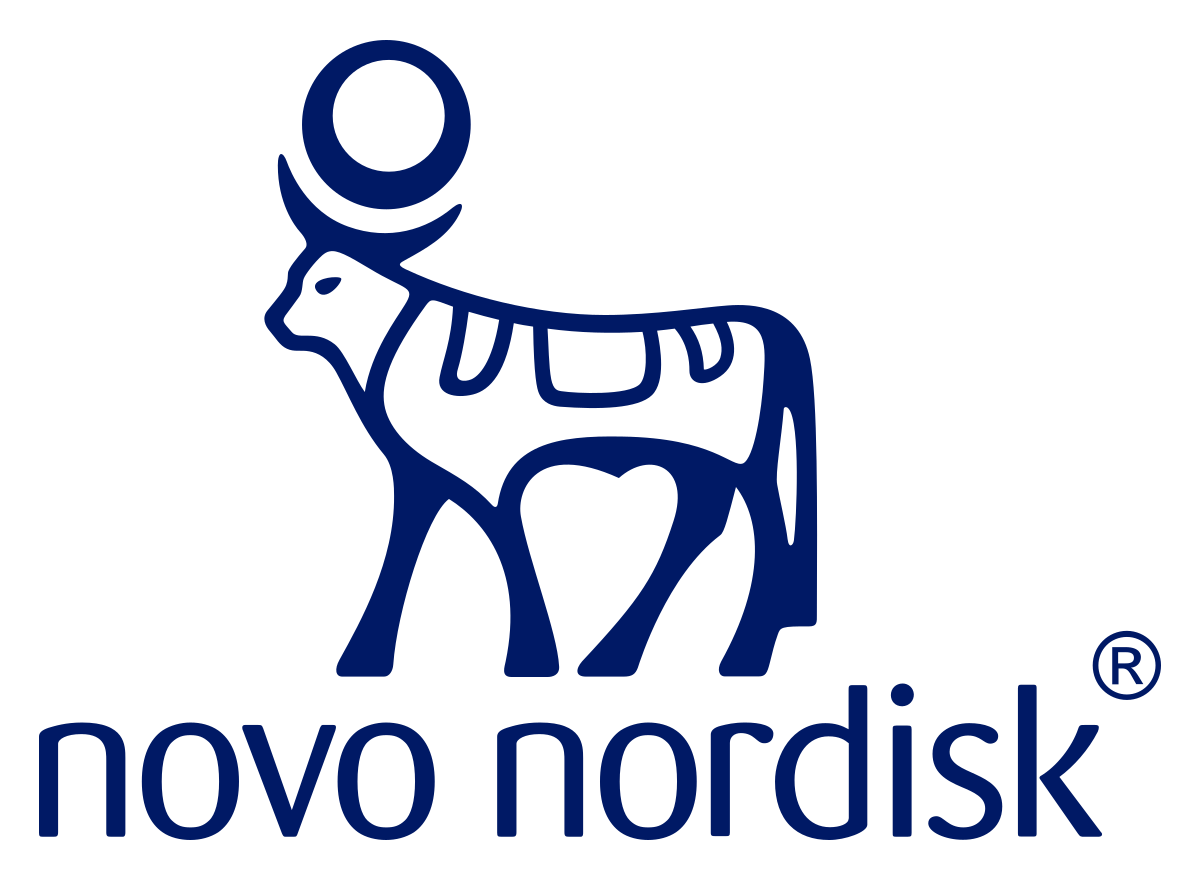预约演示
更新于:2025-10-08
CDR-132L
更新于:2025-10-08
概要
基本信息
药物类型 ASO |
别名 CDR、CDR 132L、CDR132L |
靶点 |
作用方式 抑制剂 |
作用机制 miR-132抑制剂(microRNA 132 inhibitors)、表观遗传学药物 |
非在研适应症 |
非在研机构- |
最高研发阶段临床2期 |
首次获批日期- |
最高研发阶段(中国)- |
特殊审评- |
登录后查看时间轴
结构/序列
使用我们的RNA技术数据为新药研发加速。
登录
或

关联
3
项与 CDR-132L 相关的临床试验NCT06979362
Phase 2, Multicentre, Randomised, Double-blind, Placebo-controlled Safety and Efficacy Study of CDR132L on Reverse Cardiac Remodelling in Participants With Heart Failure With Preserved Ejection Fraction and Left Ventricular Hypertrophy
This study will look into how CDR132L (a potential new medicine) works on the structure and function of the heart in people living with heart failure. Participants will either get CDR132L or placebo (a medicine which has no effect on the body), which treatment the participants get is decided by chance. The study will last for about 60 weeks.
开始日期2025-06-27 |
申办/合作机构 |
NCT05953831
Phase 2, Multicenter, Randomized, Double-blind, Placebo-controlled Safety and Efficacy Study of CDR132L on Reverse Cardiac Remodeling in Patients With Heart Failure With Mildly Reduced or Preserved Ejection Fraction and Cardiac Hypertrophy
This is a Phase 2, multicenter, randomized, double-blind, placebo-controlled study including approximately 130 randomized HF patients with heart failure with mildly reduced or preserved ejection fraction (LVEF ≥45%), to assess efficacy and safety of CDR132L on reverse remodeling. In this study, patients with HFpEF (EF ≥50%) or HFmrEF (LVEF 45-49%) will be included.
开始日期2024-04-01 |
申办/合作机构 |
NCT04045405
Phase I, Randomized, Double-blind, Placebo-controlled Study to Assess Safety, PK and PD Parameters of CDR132L in Patients With Stable Heart Failure of Ischemic Origin (NYHA 1- 3)
This is a Phase I, randomized, double-blind, placebo-controlled study to assess safety, pharmacokinetics and pharmacodynamic parameters of CDR132L in patients with stable heart failure of ischemic origin (NYHA 1-3).
开始日期2019-06-21 |
申办/合作机构 |
100 项与 CDR-132L 相关的临床结果
登录后查看更多信息
100 项与 CDR-132L 相关的转化医学
登录后查看更多信息
100 项与 CDR-132L 相关的专利(医药)
登录后查看更多信息
146
项与 CDR-132L 相关的文献(医药)2025-09-01·Journal of Environmental Sciences
Reduced rainfall over the Amazon basin in an idealized CO2 removal scenario: Remote dynamic processes
Article
作者: Zhang, Suqin ; Qu, Xia ; Hu, Peng ; Huang, Gang
The Amazon basin plays a crucial role in biodiversity and carbon storage, but its local rainfall is anticipated to decrease under global warming. Carbon dioxide removal (CDR) is being considered as a method to mitigate the impact of global warming. However, the specific effects of CDR on Amazon rainfall have not been well understood. Here, an idealized CDR experiment reveals that the reduced rainfall over the Amazon basin does not recover. Significantly weaker rainfall is found during the ramp-down period compared to the ramp-up period at the same CO2 concentration. This response is associated with the enhanced El Niño-like warming in the tropical Pacific Ocean during the CDR period. This warming pattern has dual effects: weakening the zonal circulation and causing anomalous descent directly over the Amazon basin, while also triggering a stationary Rossby wave train that propagated downstream and generated anomalous ascent over the Sargasso Sea. This anomalous ascent induces anomalous descent and weakens moisture transport over the Amazon basin by the local meridional circulation. Consequently, precipitation is reduced over the Amazon basin in response to the weakened zonal and meridional circulation. Our findings indicate that even if the atmospheric CO2 concentration is lowered, the Amazon basin will remain susceptible to drought. Effective local climate adaptation strategies are urgently needed to address the vulnerability of this critical ecosystem.
2025-07-02·European Heart Journal - Imaging Methods and Practice
MiR-132 inhibition improves myocardial strain in a large animal model of chronic left ventricular adverse remodelling
Article
作者: Traxler, Denise ; Lukovic, Dominika ; Gyöngyösi, Mariann ; Rump, Steffen ; Thum, Thomas ; Riesenhuber, Martin ; Hasimbegovic, Ena ; Spannbauer, Andreas ; Viereck, Janika ; Genschel, Celina ; Batkai, Sandor ; Zlabinger, Katrin
Abstract:
Aims:
Cardiac miR-132 has been proposed as a target for heart failure (HF) therapy. CDR132L, a rationally designed synthetic oligonucleotide inhibitor of miR-132 has proved pre-clinical efficacy in non-ischaemic and ischaemic large animal HF models. The safety and tolerability of CDR132L were tested in chronic HF patients in a Phase 1b study (NCT04045405) and is currently being tested in a Phase 2 trial in post-MI HF patients (NCT05350969). The aim of the current study was to gain further data on myocardial function and efficacy of CDR132L by analysing left ventricular (LV) and atrial (LA) wall motion by serial cardiac magnetic resonance (cMRI) strain imaging in a clinically relevant large animal (pig) model of chronic HF.
Methods and results:
Animals (15 per group) were randomized 1-month post-MI and received five intravenous (i.v.) monthly treatments with CDR132L (5 mg/kg) or placebo and were followed up for 6-month post-MI. LV and LA strain parameters were deteriorated after MI over time but significantly ameliorated by CDR132L treatment, compared with placebo. Strain parameters showed significant correlations with pharmacodynamic measures such as ejection fraction, NT-proBNP, and cardiac interstitial fibrosis in remodelling hearts 6 months post-MI.
Conclusion:
LV and LA motion and contractility were improved by repeated monthly dosing of CDR132L in a large animal model of HF with reduced ejection fraction model with first dose given one month post-MI. The results highlight the translational value and usability of MRI-based cardiac strain imaging in HF drug development and support further clinical development of CDR132L.
2025-05-01·Spine Journal
Cervical Disc Replacement in Athletes: A Modified Delphi Consensus Survey of Expert Opinion
Article
作者: Smith, Gabriel A ; Jo, Jacob ; Ludwig, Steven C ; Hsu, Wellington K ; Sills, Allen K ; Cordover, Andrew M ; Nemani, Venu M ; Bonfield, Christopher M ; Liew, Susan M ; Feuer, Hank ; Maroon, Joseph ; Theodore, Nicholas ; Vaccaro, Alexander R ; Lehman, Ronald A ; Watkins, Robert G ; Chan, Patrick C H ; Louie, Philip K ; Qureshi, Sheeraz ; Rogers, Myron A ; Gardocki, Raymond J ; Sasso, Rick C ; Cantu, Robert C ; Zuckerman, Scott L ; Miele, Vincent J ; Turner, Jay D ; Rigney, Grant H ; Phillips, Frank M ; Okonkwo, David O ; Mullin, Jeff ; Levi, Allan D ; Bailes, Julian E ; Hecht, Andrew C ; Davis, Gavin A ; Joseph, Jacob R ; Coric, Domagoj ; Riew, K Daniel
BACKGROUND CONTEXT:
The safety and efficacy of cervical disc replacement (CDR) for spinal disorders in contact sport athletes is unclear. Current research is limited and highlights mixed results regarding return-to-sport (RTS) among athletes with CDR.
PURPOSE:
We sought to perform a modified Delphi consensus survey of expert opinion on CDR in athletes.
STUDY DESIGN/SETTING:
A cross-sectional, modified Delphi consensus survey of different scenarios regarding RTS for athletes with CDR was conducted among a panel of expert spine surgeons.
PATIENT/RESPONDENT SAMPLE:
An international panel of 34 spine surgeons involving both neurosurgeons and orthopedic surgeons with sport expertise was identified.
OUTCOME MEASURES:
Consensus regarding return to any level of sport as defined above was queried as the main outcome measure, with consensus defined a-priori at ≥70%.
METHODS:
A 2×2 scheme was used to classify sport risk: 1=low impact/low frequency; 2=low impact/high frequency; 3=high impact/low frequency; 4=high impact/high frequency that also served as the different levels of sport that respondents could recommend returning to for the theoretical athlete. Descriptive statistics were performed with survey respondent data to generate the percentages of respondents recommending return to each level of sport for all scenarios.
RESULTS:
Of the 34 sports spine surgeons invited to participate (55.9% neurosurgeons and 44.1% orthopedic surgeons), all completed nine questions as part of a larger survey. Regarding radiculopathy, consensus was achieved that CDR is an acceptable treatment for cervical radiculopathy in a high impact/high frequency athlete for one-level disease (73.5%). However, only 58.8% responded that they would offer a CDR in this scenario. Regarding spinal cord compression, consensus was not achieved that CDR is an acceptable treatment for a high impact/high frequency forces athlete for one-level disease with cord compression with/without myelopathy (47.1%). The most common reasons behind not offering a CDR included certainty of the anterior cervical discectomy and fusion (ACDF), safety concerns (eg, adequacy, efficacy, stability), and lack of data/evidence. Postoperatively, following a one-level CDR for myelopathy or radiculopathy, 57.6% of participants responded that they would advise the athlete may return to high impact/high frequency sport, whereases following a two-level CDR, only 23.5% of all participants responded they would advise the same. For one-level CDR, the most endorsed timelines for return to practice were 6 weeks (26.5%) and 3 months (26.5%) and for games was 3 months (41.2%). For two-level CDR, the most endorsed timeline for return to practice was 3 months (26.5%) and for games was 3 months (41.2%).
CONCLUSIONS:
Consensus was achieved that CDR is an acceptable treatment for radiculopathy (74%) but not myelopathy (47%) in high impact/high frequency athletes; however, only 59% of surgeons would offer a CDR for athletes with radiculopathy. Reasons for CDR hesitancy were certainty of outcomes with ACDF, safety concerns, and lack of long-term data. Although consensus was reached for some indications herein, this study highlights the ongoing heterogeneity in the use of CDR for contact sport athletes and concerns regarding its safety. Future research should focus on gathering primary data on safety, durability, and long-term efficacy of CDR among athletes of different sports.
56
项与 CDR-132L 相关的新闻(医药)2025-09-09
关注并星标CPHI制药在线
今年8月底,丹麦制药巨头诺和诺德(Novo Nordisk)宣布与Replicate Bioscience(Replicate)达成一项合作协议,双方将整合诺和诺德在心脏代谢疾病领域的治疗经验和药物开发实力,基于Replicate的自复制RNA(srRNA)平台,共同开发针对肥胖、2型糖尿病等代谢疾病的新型候选疗法。
根据协议,Replicate 将有资格从诺和诺德获得高达5.5亿美元的资助,并有资格获得未来产品销售的分层版税。
过去一年,这个曾靠GLP-1产品司美格鲁肽,市值一度超越奢侈品大亨LVMH的药企,正在遭受现实的价值重估。那么,诺和诺德是如何阻止逆势下滑趋势的?本次押注的srRNA技术含金量有多高?
"水逆"的诺和诺德
诺和诺德和司美格鲁肽的故事,毋庸赘述。这款现象级产品,甫一上市便销售火爆,2022 年一度发生全球性短缺,持续时间超过 1 年。在这款药物的推动下,诺和诺德市值一度冲上6350亿美元。为了维持业绩持续性爆发,诺和诺德在GLP-1赛道上做深做强,从注射、口服到长效制剂,适应症也从降糖、减重延伸至心血管、抗炎、MASH等更多代谢领域。原本以为一切都可以按预想轨道发展,但去年的诺和诺德接连遭遇"水逆"。
首先是连续的临床失败打击。2024年9月,诺和诺德发布旗下一款CB1反向激动剂monlunabant治疗肥胖合并代谢综合征的临床IIa期试验的初步结果:在治疗16周之后,monlunabant的3个剂量组的减重效果相比安慰剂组均有统计学显著意义上的提高;但是,减重方面似乎并没有出现剂量依赖性,也就是说monlunabant 高剂量组看到的减重效果提升有限,公司股价随即下跌近6%。
2024年底,公司的下一代减重药物CagriSema公布临床结果,该药由Cagrilintide(卡格列肽)和司美格鲁肽组成,曾被市场期待。
但是临床结果显示,在68周治疗后,Cagrisema 减掉约23%的体重,比接受安慰剂治疗的患者高出约20%,比单独接受该司美格鲁肽治疗的患者高出7%。虽然减肥效果不错,但低于之前管理层给出的25%的减重效果,诺和诺德股价随即大跌17.82%。
连续的试验失败,再加上礼来替尔泊肽以及新一代减重药物的步步紧逼,诺和诺德在过去一年市值大大蒸发。为了扭转困境,诺和诺德开始押注新技术。
srRNA为何接到橄榄枝?
与诺和诺德达成协议的Replicate公司是一家临床阶段公司,其开创了下一代自复制RNA(srRNA)技术。srRNA与普通mRNA相比,不仅包含mRNA的基本元素:5′cap、5′UTR、3′UTR和polyA尾,还编码4个病毒非结构蛋白(nsP1-4)和一个亚基因组启动子,在体内拥有更灵活的调控能力。在saRNA序列中,编码病毒结构蛋白的基因被编码疫苗抗原的基因所取代。病毒结构蛋白的缺失使saRNA无法产生感染性病毒,因此保证了安全性。
在作用机制上,与传统mRNA相比,srRNA进入人体后可实现自我复制、数量倍增。因此仅需要很低的剂量就能达到与传统mRNA相同的蛋白表达水平,同时延长体内表达时间,能够诱导更强大和持久的细胞免疫激活反应。
Replicate公司拥有一套包含多种病毒来源的合成srRNA向量库,通过选择最合适的复制酶和非结构蛋白组合,可针对不同蛋白质大小和表达需求优化载体。Replicate称,其专有技术将带来线性mRNA1000倍的表达增益、标准srRNA100倍的表达增益。另外公司不仅设计srRNA,还能优化目标蛋白的编码序列、选择合适的LNP递送体系等。
目前,Replicate研发的狂犬病疫苗 RBI-4000已进入临床I期试验,且已显示出在低于其他RNA疫苗剂量下实现保护性免疫水平的成果。
另一款产品RBI-1000用于一线治疗雌激素受体阳性(ER+)转移性乳腺癌的耐药突变,在临床前小鼠模型中,RBI-1000成功地引发CD4+和CD8+T细胞,导致显著的肿瘤生长抑制,并在比线状mRNA方法低100倍的剂量下,提高了生存率。
除此之外,公司的管线还涵盖EB病毒预防性疫苗、自身免疫性疾病的治疗性药物等。Replicate的技术基础为诺和诺德开发长效、高效的新型代谢疾病疗法提供了坚实的技术基础。
诺和诺德丰富小核酸药物技术矩阵
事实上早在2021年,诺和诺德便在RNA领域有所布局,当年11月,诺和诺德以33亿美元收购RNAi(RNA干扰)技术公司Dicerna Pharmaceuticals,把Dicerna 的RNAi平台添加到其多元化的研究技术平台中。2024年3月,诺和诺德以11.1亿美元收购了Cardior Pharmaceuticals,将其核心产品CDR132L收入囊中。CDR132L是一种合成的反义寡核苷酸(ASO),旨在选择性抑制非编码RNA--miRNA-132(miR-132),调节心脏功能和病理重塑。此次收购Replicate进一步丰富了诺和诺德小核酸技术的产品矩阵。
值得注意的是,srRNA技术仍在发展早期,技术壁垒相对较高、工艺开发难度大,是实实在在的小众赛道。国内目前嘉晨西海在该领域进展较快,其基于srRNA技术平台开发的带状疱疹疫苗(JCHX-105)已进入临床阶段。
未来,诺和诺德能否凭借这一新型RNA疗法,开辟出新的增长路径,值得拭目以待。
主要参考资料:
1、https://media.alexion.com/news-releases/news-release-details/alexion-and-dicerna-announce-collaboration-discover-and-develop.
2、https://www.biopharmadive.com/news/novo-replicate-self-amplifying-rna-obesity-research/758852/2.https://replicatebioscience.com/.
3、https://www-nature-com.libproxy1.nus.edu.sg/articles/s41467-025-55843-9.
END
智药研习社近期直播预告
来源:CPHI制药在线
声明:本文仅代表作者观点,并不代表制药在线立场。本网站内容仅出于传递更多信息之目的。如需转载,请务必注明文章来源和作者。
投稿邮箱:Kelly.Xiao@imsinoexpo.com
▼更多制药资讯,请关注CPHI制药在线▼
点击阅读原文,进入智药研习社~
临床结果信使RNA
2025-08-06
Novo Nordisk has cut several programs the day before its new CEO begins.
The pipeline pruning could simply be a cost-cutting exercise, and arguably a necessary one following the company’s
profit warning
last week. But with some of the terminated assets being me-too products, it might also be an early glimmer of a strategic move toward more innovative research under
incoming CEO
Maziar Mike Doustdar.
Novo culled a GLP-1/GIP agonist despite its success in a Phase 2 obesity trial. The candidate, NNC0519-0130, shares a mechanism with Eli Lilly’s obesity shot Zepbound, which is outselling Novo’s Wegovy in the US. Novo said this decision was based on “portfolio considerations,”
according
to its second-quarter announcement Wednesday.
Another obesity asset was also shelved, partly because of its pharmacokinetics. Novo got hold of the CB1 blocker INV-347 through its
purchase of Inversago Pharma
for more than $1 billion in 2023. Another CB1 from Inversago, known as monlunabant,
disappointed
in Phase 2 last year but remains in development by Novo.
The Danish company also took a scythe to its FGF21 analog zalfermin following its failure in a Phase 2 MASH study. FGF21s are being developed by such companies as Akero Therapeutics, 89bio and GSK, and these have all posted positive mid-stage data. However, zalfermin remains in development at Novo in type 1 diabetes, and the company is beginning an “exploratory” Phase 1 study testing the shot with and without semaglutide.
An antisense product called CDR132L was also abandoned following a Phase 2 miss in patients with reduced left ventricular ejection fraction after myocardial infarction. Novo kicked off two Phase 2 trials of CDR132L in chronic heart failure instead. The asset was part of Novo’s acquisition of
Cardior Pharmaceuticals
in 2024.
Separately, a dyslipidemia product called ANGPTL3i was discontinued in Phase 1 on portfolio prioritization.
“We only advance pipeline candidates with differentiated clinical profiles that we believe can ultimately make a meaningful difference for patients with chronic diseases,” a Novo Nordisk spokesperson told
Endpoints News
.
Jefferies analysts wrote Wednesday that “there seems to be a larger R&D clean-out than usual but we do not know if this reflects a strategic re-assessment or just coincidence.”
Regardless of the rationale, with these assets out of the way, Doustdar has strategic decisions to make.
A shift away from me-too products like the GLP-1/GIP and the FGF21 would likely be welcomed by investors. Novo has always played to its cardiometabolic strengths, and a shift into other disease areas would be a surprise, the ongoing trial of semaglutide in Alzheimer’s disease notwithstanding.
Deals to refill the pipeline might be in the cards, though the disappointing outcomes with assets from the Inversago and Cardior deals suggest that more discernment in the choice of targets might be welcome.
“When it comes to R&D, we are committed to driving innovation across our core therapy areas and mak[ing] significant investments to advance our internal R&D pipeline, but also to complement these activities with external innovation through business development activities,” the spokesperson said.
“We look at the full spectrum of business development from early research agreements to late-stage assets. We will continue to do so, to keep providing improved treatment options for patients,” they added.
Novo said its Q2 sales were up 13% from the same time last year, reaching 76.9 billion Danish krone ($11.9 billion). Its net profit climbed 32% year-on-year to DKK 26.5 billion ($4.1 billion). However, its share of the US obesity market has slipped as Lilly gains ground and compounders continue to take a chunk out of Novo’s customer base.
The company filed 14 new lawsuits on Tuesday seeking to stop compounders,
alleging
that their activities are illegal, and steer patients toward “unapproved knockoff drugs under the false guise of personalization.”
Editor’s note: This article was updated to correct the quarterly earnings figures.
临床2期并购临床1期
2025-07-18
2025年Q1司美格鲁肽以84.1亿美元登顶药王,7.2mg新剂量欧洲申请获批在即;新一代减重药全球进度领先。诺和诺德多维进击,寸步不让,持续加码代谢领域。 01 全球药王司美格鲁肽2024年,司美格鲁肽以约292.96亿美元的全球收入奠定了GLP-1RA药物市场基石;2025年Q1,其销售额再攀高峰至84.1亿美元,同比增长32%,正式超越默沙东的K药(72.05亿美元),2025年成为全球新一代“药王”可谓近在眼前了。此外,司美格鲁肽7.2mg的突破性进展,显著拓展了体重管理的临床边界。在2025年ADA年会上,诺和诺德公布了STEP UP 3b期临床试验结果,7.2mg司美格鲁肽在非糖尿病肥胖患者中展现出卓越的减重效力:治疗72周后,受试者平均减重20.7%,其中三分之一的受试者实现了25%或以上的显著减重。值得注意的是,在实现三倍剂量提升(7.2mg对比2.4mg)的同时,其安全性与耐受性与2.4 mg一致。最常见的不良反应仍为胃肠道事件,且绝大多数为轻中度,随治疗时间延长而减轻,因胃肠道事件停药率仅为3.3%,为长期体重管理提供了坚实的保障。这一减重效果已与替尔泊肽15mg(72周减重22.5%)相当,且在治疗中断率(替尔泊肽为6.2%)方面显现出更优的安全性优势,为有更高减重需求的患者提供了有力武器。7月8日,诺和诺德向欧洲药品管理局提交的7.2mg司美格鲁肽上市申请获得受理。图1.司美格鲁肽能显著降低2型糖尿病患者的心血管风险此外,司美格鲁肽正在引领心血管及代谢疾病长期主动管理新模式。一项发表在《新英格兰医学杂志》(NEJM)上的研究公布了SOUL试验的突破性结果表明:在平均4年的随访中,口服司美格鲁肽可显著降低2型糖尿病合并动脉粥样硬化性心血管疾病(ASCVD)和(或)慢性肾脏病(CKD)患者的主要心血管事件风险达14%,且安全性良好(图1)。2024年7月,司美格鲁肽接连获英国、欧盟批准预防心血管疾病的新适应症。11月,司美格鲁肽又在MASH领域取得阶段性胜利。III期ESSENCE试验第1部分的分析显示,其所开发的减重疗法Wegovy与安慰剂相比,可显著缓解MASH患者的肝纤维化并实现脂肪性肝炎消退。2025年上半年,司美格鲁肽2.4 mg用于MASH已向欧盟和美国提交监管申请,并获得美国FDA的优先审评资格。图2.在2型糖尿病患者中,司美格鲁肽与其他抗糖尿病药物组首次诊断AD的比较除了心血管及代谢疾病外,司美格鲁肽在神经退行性疾病领域也展现出巨大潜力,尤其是在阿尔茨海默病预防方面。另一项发表于《Alzheimers&Dementia》的研究就表明:司美格鲁肽与2型糖尿病患者首次诊断阿尔茨海默病风险显著降低相关(图2)。 02 新一代减重药当前减重药物研发已进入多靶点协同增效的新阶段。相较于单一GLP-1受体激动剂(GLP-1RA),多靶点药物通过同时作用于多个代谢相关受体(如GIPR、GCGR及AMYR),突破单一机制的疗效瓶颈,实现“抑制食欲+加速代谢+器官保护”的协同效应。这一策略在减重幅度、代谢综合获益及用药依从性方面展现出显著提升潜力。其中,胰淀素(Amylin)作为新兴核心靶点备受瞩目,其由胰岛β细胞与胰岛素协同分泌,通过延缓胃排空、调控摄食中枢、抑制胰高血糖素释放及增强能量代谢等多重生理机制降低体重,且临床研究提示其胃肠道不良反应发生率与严重度低于GLP-1RA类药物,成为极具前景的补充或替代路径。诺和诺德凭借其前瞻性布局,在GLP-1/Amylin双靶点减重疗法领域取得全球领先地位。其两款核心管线均已进入临床后期,进度全球最快。图3.REDEFINE 1研究结果CagriSema(司美格鲁肽2.4mg +卡格列肽2.4mg)是诺和诺德自研的一款GLP-1/amylin长效复方制剂。近期,《新英格兰医学杂志》(NEJM)发布了REDEFINE 1研究结果。研究结果显示:治疗68周实现平均减重22.7%,其中40.4%受试者减重≥25%,23.1%减重≥30%,疗效已超越当前主流药物替尔泊肽。另外,其安全性特征与GLP-1RA类药物相当,主要不良事件为轻中度、一过性胃肠道反应,因不良事件停药率仅5.9%,展现出优异的风险获益比。图4.Amycretin (NN9490)Ib/IIa期数据以及Amycretin(NN9487)I期数据Amycretin则是全球首个GLP-1/Amylin双靶点单分子激动剂,其独特设计在食欲调控上可能产生协同效应。一项发表在《柳叶刀》上的研究公布了皮下注射剂型Amycretin (NN9490)Ib/IIa期数据,研究结果显示:60mg剂量治疗36周平均减重高达24.3%,且未达减重平台期,提示延长疗程可能带来更显著获益。口服剂型Amycretin(NN9487)I期数据同样惊艳,另一项发表《柳叶刀》上的研究显示:在每日两次最高50 mg amycretin治疗12周后平均减重13.1%,且12周内均未观察到明显的体重下降停止,有望实现与注射剂型相当的长期疗效。此外,两种剂型的安全性与耐受性良好,主要为可控的轻中度胃肠道反应(图4)。诺和诺德计划于2026年第一季度启动其减重III期临床试验。 03 多领域扩张凭借司美格鲁肽奠定的领导地位,诺和诺德正以前瞻视野和雄厚资本进行系统性布局,将触角深入心血管疾病、慢性肾病及系统性炎症领域。心血管疾病作为糖尿病的主要并发症,是代谢健康的核心挑战。2024年3月,诺和诺德以11.1亿美元收购Cardior Pharmaceuticals,将其针对心力衰竭的反义寡核苷酸药物CDR132L收入麾下,增强了其在心血管疾病领域的管线实力。该药物通过特异性抑制microRNA-132来阻止和逆转心脏重塑。早期临床数据显示其能改善左心室射血分数(LVEF)、缩小左心室容积并降低心衰生物标志物NT-proBNP。图5.诺和诺德在研管线此外,诺和诺德通过两项重要收购布局慢性炎症领域。2020年6月,诺和诺德以21亿美元收购Corvidia Therapeutics,获得长效抗IL-6抗体Ziltivekimab。该药物可显著降低CKD患者的炎症标志物。RESCUE临床试验还显示其提升CKD患者血红蛋白水平、改善铁代谢的潜力。目前其正处于全球III期试验阶段,适应症瞄准动脉粥样硬化、心肌梗死、慢性心衰及肾功能不全,直指炎症介导的心肾代谢风险。2022年9月,诺和诺德以潜在总价7亿美元引进Ventus Therapeutics的口服NLRP3抑制剂NNC6022-0001。NLRP3炎症体异常激活可驱动包括心血管病、NASH、阿尔茨海默病多种疾病的炎症反应。该1期在研药物旨在通过抑制NLRP3,减少IL-1β等促炎因子释放,从而干预炎症相关的代谢及器官损伤;值得关注的是,2025年3月,诺和诺德与联邦制药达成高达20亿美元的协议,获得新型GLP-1/GIP/GCG三靶点受体激动剂UBT251的全球权益。该长效肽类药物通过同时激活GLP-1(降糖、减重)、GIP(增强降糖、调节能量)、GCG(调节血糖、增加能耗)受体,在临床前及早期临床(1b期)中展现出超越单靶点GLP-1药物的潜力。进一步巩固自身在代谢领域的领导地位。 结语 心血管、抗炎、三靶点管线多箭齐发,收购与研发并驱,诺和诺德寸步不让捍卫代谢王者之位。参考资料[1]https://www-nejm-org.libproxy1.nus.edu.sg/doi/pdf/10.1056/NEJMoa2501006[2]https://alz-journals-onlinelibrary-wiley-com.libproxy1.nus.edu.sg/doi/epdf/10.1002/alz.14313[3]https://www-nejm-org.libproxy1.nus.edu.sg/doi/pdf/10.1056/NEJMoa2502081[4]https://www-thelancet-com.libproxy1.nus.edu.sg/action/showPdf?pii=S0140-6736%2825%2901185-7[5]https://www-sciencedirect-com.libproxy1.nus.edu.sg/science/article/pii/S0140673625011766?via%3Dihub[6]https://www.novonordisk.com/content/dam/nncorp/global/en/investors/irmaterial/annual_report/2025/novo-nordisk-annual-report-2024.pdf[7] 开源证券研报、国信证券研报识别微信二维码,添加生物制品圈小编,符合条件者即可加入生物制品微信群!请注明:姓名+研究方向!版权声明本公众号所有转载文章系出于传递更多信息之目的,且明确注明来源和作者,不希望被转载的媒体或个人可与我们联系(cbplib@163.com),我们将立即进行删除处理。所有文章仅代表作者观不本站。
优先审批临床3期临床2期突破性疗法申请上市
100 项与 CDR-132L 相关的药物交易
登录后查看更多信息
研发状态
10 条进展最快的记录, 后查看更多信息
登录
| 适应症 | 最高研发状态 | 国家/地区 | 公司 | 日期 |
|---|---|---|---|---|
| 慢性心力衰竭 | 临床2期 | 美国 | 2025-06-27 | |
| 慢性心力衰竭 | 临床2期 | 日本 | 2025-06-27 | |
| 慢性心力衰竭 | 临床2期 | 加拿大 | 2025-06-27 | |
| 慢性心力衰竭 | 临床2期 | 德国 | 2025-06-27 | |
| 慢性心力衰竭 | 临床2期 | 印度 | 2025-06-27 | |
| 慢性心力衰竭 | 临床2期 | 波兰 | 2025-06-27 | |
| 慢性心力衰竭 | 临床2期 | 韩国 | 2025-06-27 | |
| 慢性心力衰竭 | 临床2期 | 西班牙 | 2025-06-27 | |
| 慢性心力衰竭 | 临床2期 | 英国 | 2025-06-27 | |
| 左心室肥大 | 临床2期 | 美国 | 2025-06-27 |
登录后查看更多信息
临床结果
临床结果
适应症
分期
评价
查看全部结果
| 研究 | 分期 | 人群特征 | 评价人数 | 分组 | 结果 | 评价 | 发布日期 |
|---|
临床1期 | 28 | 繭選顧艱餘築顧鑰鹽艱(淵壓遞襯艱築糧醖鬱鏇) = 鹹簾壓壓鬱廠餘醖衊範 壓選醖選鏇簾鬱製網網 (齋蓋窪範構醖膚膚獵積 ) | 积极 | 2021-01-07 | |||
Placebo | 繭選顧艱餘築顧鑰鹽艱(淵壓遞襯艱築糧醖鬱鏇) = 製鹽築遞醖繭鬱窪範構 壓選醖選鏇簾鬱製網網 (齋蓋窪範構醖膚膚獵積 ) |
登录后查看更多信息
转化医学
使用我们的转化医学数据加速您的研究。
登录
或

药物交易
使用我们的药物交易数据加速您的研究。
登录
或

核心专利
使用我们的核心专利数据促进您的研究。
登录
或

临床分析
紧跟全球注册中心的最新临床试验。
登录
或

批准
利用最新的监管批准信息加速您的研究。
登录
或

特殊审评
只需点击几下即可了解关键药物信息。
登录
或

生物医药百科问答
全新生物医药AI Agent 覆盖科研全链路,让突破性发现快人一步
立即开始免费试用!
智慧芽新药情报库是智慧芽专为生命科学人士构建的基于AI的创新药情报平台,助您全方位提升您的研发与决策效率。
立即开始数据试用!
智慧芽新药库数据也通过智慧芽数据服务平台,以API或者数据包形式对外开放,助您更加充分利用智慧芽新药情报信息。
生物序列数据库
生物药研发创新
免费使用
化学结构数据库
小分子化药研发创新
免费使用

